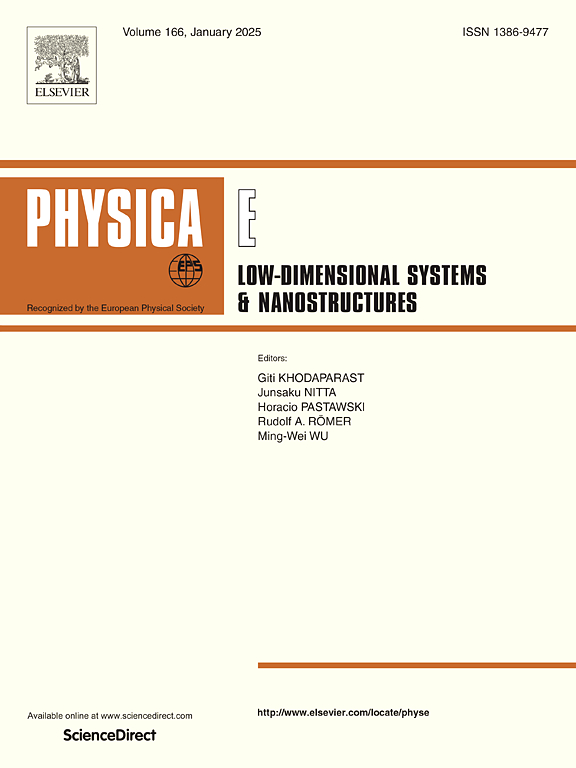黑色磷二烯的各向异性导热性能
IF 2.9
3区 物理与天体物理
Q3 NANOSCIENCE & NANOTECHNOLOGY
Physica E-low-dimensional Systems & Nanostructures
Pub Date : 2025-07-08
DOI:10.1016/j.physe.2025.116330
引用次数: 0
摘要
本文研究了磷烯的总各向异性电子热导率,重点研究了声子和电子的贡献。利用准经典近似下的玻尔兹曼动力学方程,我们推导了扶手椅(AC)和之字形(ZZ)方向上的电子导热系数的解析表达式。我们的研究结果表明,在室温(300 K)下,电子导热系数表现出显著的方向依赖性,zz方向的值比ac方向的值大一个数量级。各向异性归因于沿这些方向有效电子质量的差异。我们还探讨了热导率对温度梯度和热通量矢量之间夹角的依赖性的非单调行为,为热输运的电子贡献提供了见解。结果表明,这种角度依赖性的实验测量可用于定量分离磷烯中的电子效应,进一步扩大其在电子学和光电子学中的潜在应用。本文章由计算机程序翻译,如有差异,请以英文原文为准。
Anisotropic thermal conductivity properties of black phosphorene
This paper investigates the total anisotropic electronic thermal conductivity of phosphorene, focusing on both phonon and electronic contributions. Utilizing the Boltzmann kinetic equation within the quasi-classical approximation, we derive analytical expressions for the electronic thermal conductivity in both armchair () and zigzag () directions. Our findings reveal that the electronic thermal conductivity exhibits significant directional dependence, with values in the -direction being an order of magnitude greater than those in the -direction at room temperature (300 K). The anisotropy is attributed to the differences in effective electron masses along these directions. We also explore the non-monotonic behavior of the dependence of the thermal conductivity on the angle between the temperature gradient and heat flux vectors, offering insights into the electronic contributions to thermal transport. The results suggest that experimental measurements of this angular dependence can be used to quantitatively isolate electronic effects in phosphorene, furthering its potential applications in electronics and optoelectronics.
求助全文
通过发布文献求助,成功后即可免费获取论文全文。
去求助
来源期刊
CiteScore
7.30
自引率
6.10%
发文量
356
审稿时长
65 days
期刊介绍:
Physica E: Low-dimensional systems and nanostructures contains papers and invited review articles on the fundamental and applied aspects of physics in low-dimensional electron systems, in semiconductor heterostructures, oxide interfaces, quantum wells and superlattices, quantum wires and dots, novel quantum states of matter such as topological insulators, and Weyl semimetals.
Both theoretical and experimental contributions are invited. Topics suitable for publication in this journal include spin related phenomena, optical and transport properties, many-body effects, integer and fractional quantum Hall effects, quantum spin Hall effect, single electron effects and devices, Majorana fermions, and other novel phenomena.
Keywords:
• topological insulators/superconductors, majorana fermions, Wyel semimetals;
• quantum and neuromorphic computing/quantum information physics and devices based on low dimensional systems;
• layered superconductivity, low dimensional systems with superconducting proximity effect;
• 2D materials such as transition metal dichalcogenides;
• oxide heterostructures including ZnO, SrTiO3 etc;
• carbon nanostructures (graphene, carbon nanotubes, diamond NV center, etc.)
• quantum wells and superlattices;
• quantum Hall effect, quantum spin Hall effect, quantum anomalous Hall effect;
• optical- and phonons-related phenomena;
• magnetic-semiconductor structures;
• charge/spin-, magnon-, skyrmion-, Cooper pair- and majorana fermion- transport and tunneling;
• ultra-fast nonlinear optical phenomena;
• novel devices and applications (such as high performance sensor, solar cell, etc);
• novel growth and fabrication techniques for nanostructures

 求助内容:
求助内容: 应助结果提醒方式:
应助结果提醒方式:


